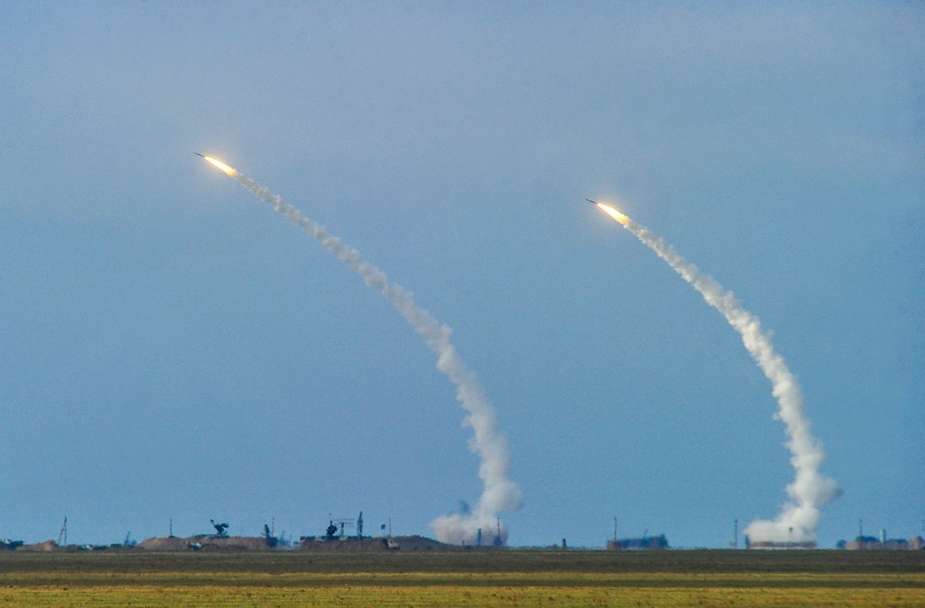In a recent development of the war in Ukraine reported by Oleh Syniehubov, the Head of the Kharkiv Regional Military Administration, Russian forces launched an air strike against the city of Kharkiv on January 3, 2023, using S-300 surface-to-air missiles. This incident marks another instance in the ongoing Ukraine conflict where the S-300 missile system, typically designed for air defense, has been repurposed for ground offensives.
Follow Army Recognition on Google News at this link

S-300 missile launch during exercises in the Kherson region. (Picture source e-news.su)
Previously, on November 15, 2022, Russia conducted several missile strikes against Ukraine. Notably, the S-300, originally intended for air defense, lacks inherent capabilities for land attacks. However, in July 2022, Ukrainian officials claimed that Russia had been adapting these missiles for ground strikes. This shift in the use of the S-300 reflects a broader trend in the conflict, showcasing the flexibility and modifications of military equipment.
The Russian military has reportedly been experimenting with the S-300 system to enhance its ground target capabilities. Modifications reportedly include the integration of GPS navigation, allowing for more precise targeting. Despite these efforts, the missile's accuracy for ground attacks has been questioned. Russian military sources claim that with certain modifications, the S-300 can effectively target key ground-based infrastructure such as headquarters, radar stations, and hangars, with a range of up to 120 kilometers when launched on a ballistic trajectory.
To repurpose the S-300 for ground attacks, two primary modifications are undertaken. Firstly, the system's radar and software algorithms are reconfigured to detect and track ground-based threats instead of aerial targets. This involves adjusting the system's parameters and algorithms to enable the identification and engagement of ground targets, such as vehicles or personnel.
Secondly, the missiles themselves are modified. To target ground threats, the missiles are equipped with different types of warheads, such as blast fragmentation or armor-piercing warheads, which are more effective against ground-based targets. Additionally, adjustments to the missile's guidance system are necessary to improve trajectory and accuracy for land targets. These adaptations underscore the evolving nature of military technology and tactics in the ongoing conflict.
The utilization of surface-to-air missiles like the S-300 by Russia for ground offensives in Ukraine hints at a deeper issue within the Russian military arsenal, potentially pointing to a shortage in their production of surface-to-surface missiles. This shift in military strategy could be a direct consequence of various challenges that Russia is currently facing.
Firstly, the global sanctions imposed on Russia in the wake of its invasion of Ukraine have had a profound impact on its economy and industrial capabilities. These sanctions, targeting key sectors including defense, have likely disrupted supply chains and hindered the production of military hardware, including surface-to-surface missiles. The isolation from global markets means that accessing the materials and technology needed for sophisticated weaponry production has become increasingly difficult.
Secondly, the sustained nature of the conflict and the high rate of missile usage have possibly led to a depletion of Russia's stockpiles of surface-to-surface missiles. Continuous military operations require a steady supply of munitions, and the longevity of the conflict might have strained Russia's reserves more than anticipated, leading to a situation where they need to adapt existing weaponry to fill the gaps.
Additionally, the production of complex military hardware like surface-to-surface missiles is a resource-intensive process that involves significant time and investment. With the ongoing economic pressures and potential damage to manufacturing infrastructure, Russia might be facing challenges in ramping up production to meet the demands of the prolonged conflict.
In this context, modifying surface-to-air missiles for ground attacks can be seen as a pragmatic approach to overcome these limitations. By adapting existing systems, Russia can continue its military operations without being heavily constrained by the shortage of purpose-built surface-to-surface missiles. This strategy also demonstrates the flexibility and resourcefulness in military tactics, albeit born out of necessity due to the constraints imposed by sanctions and production challenges.
News Russia Ukraine War















